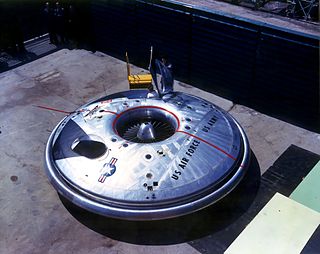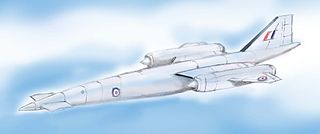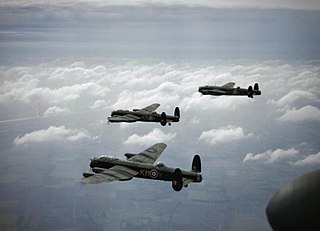
The Avro Blue Steel was a British air-launched, rocket-propelled nuclear armed standoff missile, built to arm the V bomber force. It allowed the bomber to launch the missile against its target while still outside the range of surface-to-air missiles (SAMs). The missile proceeded to the target at speeds up to Mach 3, and would trigger within 100 m of the pre-defined target point.

The Avro Vulcan is a jet-powered, tailless, delta-wing, high-altitude, strategic bomber, which was operated by the Royal Air Force (RAF) from 1956 until 1984. Aircraft manufacturer A.V. Roe and Company (Avro) designed the Vulcan in response to Specification B.35/46. Of the three V bombers produced, the Vulcan was considered the most technically advanced, hence the riskiest option. Several reduced-scale aircraft, designated Avro 707s, were produced to test and refine the delta-wing design principles.

Avro was a British aircraft manufacturer. Its designs include the Avro 504, used as a trainer in the First World War, the Avro Lancaster, one of the pre-eminent bombers of the Second World War, and the delta wing Avro Vulcan, a stalwart of the Cold War.

The Avro Canada CF-105 Arrow was a delta-winged interceptor aircraft designed and built by Avro Canada. The CF-105 held the promise of Mach 2 speeds at altitudes exceeding 50,000 feet (15,000 m) and was intended to serve as the Royal Canadian Air Force's (RCAF) primary interceptor into the 1960s and beyond.

The Avro Lancaster is a British Second World War heavy bomber. It was designed and manufactured by Avro as a contemporary of the Handley Page Halifax, both bombers having been developed to the same specification, as well as the Short Stirling, all three aircraft being four-engined heavy bombers adopted by the Royal Air Force (RAF) during the same era.

The Avro Shackleton is a British long-range maritime patrol aircraft (MPA) which was used by the Royal Air Force (RAF) and the South African Air Force (SAAF). It was developed by Avro from the Avro Lincoln bomber, which itself had been a development of the famous wartime Avro Lancaster bomber.

The Avro 679 Manchester was a British twin-engine heavy bomber developed and manufactured by the Avro aircraft company in the United Kingdom. While not being built in great numbers, it was the forerunner of the more famed and more successful four-engined Avro Lancaster, which was one of the most capable strategic bombers of the Second World War.

The Bristol Type 188 is a supersonic research aircraft designed and produced by the British aircraft manufacturer Bristol Aeroplane Company. It was nicknamed the Flaming Pencil in reference to its length and relatively slender cross-section as well as its intended purpose.

The Saunders-Roe SR.53 was a British prototype interceptor aircraft of mixed jet and rocket propulsion developed for the Royal Air Force (RAF) by Saunders-Roe in the early 1950s. As envisaged, the SR.53 would have been used as an interceptor aircraft, using its rocket propulsion to rapidly climb and approach incoming hostile bombers at high speeds; following its attack run, the aircraft would then return to its base using jet propulsion.

The Avro Canada CF-100 Canuck is a Canadian twinjet interceptor/fighter designed and produced by aircraft manufacturer Avro Canada. It has the distinction of being the only Canadian-designed fighter to enter mass production.

A rocket-powered aircraft or rocket plane is an aircraft that uses a rocket engine for propulsion, sometimes in addition to airbreathing jet engines. Rocket planes can achieve much higher speeds than similarly sized jet aircraft, but typically for at most a few minutes of powered operation, followed by a gliding flight. Unhindered by the need for oxygen from the atmosphere, they are suitable for very high-altitude flight. They are also capable of delivering much higher acceleration and shorter takeoffs. Many rocket aircraft may be drop launched from transport planes, as take-off from ground may leave them with insufficient time to reach high altitudes.

The Republic XF-103 was an American project to develop a powerful missile-armed interceptor aircraft capable of destroying Soviet bombers while flying at speeds as high as Mach 3. Despite a prolonged development, it never progressed past the mockup stage.

The Avro Canada VZ-9 Avrocar was a VTOL aircraft developed by Avro Canada as part of a secret U.S. military project carried out in the early years of the Cold War. The Avrocar intended to exploit the Coandă effect to provide lift and thrust from a single "turborotor" blowing exhaust out of the rim of the disk-shaped aircraft. In the air, it would have resembled a flying saucer.

The Avro 730 was a planned Mach 3 reconnaissance aircraft and strategic bomber that was being developed by Avro Aircraft for the Royal Air Force (RAF). It had been originally envisioned as a very high-speed aircraft to perform aerial reconnaissance missions, conforming with the requirements of Air Ministry Specification OR.330. Avro subsequently decided to modify the design of the proposed 730 in order to accommodate its arming with nuclear weapons; this change therefore meant that the type would be able to perform the nuclear weapons delivery mission as well, which had been called for under Air Ministry Specification RB.156T which sought a high speed reconnaissance-bomber aircraft.
The Handley Page HP.100 was a tendered submission to build a long-range, high-speed reconnaissance aircraft for the Royal Air Force, able to overfly Soviet territory in the face of anti-aircraft defences, and to supply information for the V bomber force carrying nuclear weapons.

Number 44 (Rhodesia) Squadron was an aviation unit of the Royal Air Force. It was active between 1917 and 1982. For most of its history it served as a heavy bomber squadron.

The SNCASE SE.212 Durandal was a French jet and rocket mixed-power experimental fighter aircraft of the mid-1950s.

The Avro 720 was an in-development British single-seat interceptor of the 1950s. It was designed and being developed by Avro in competition with the Saunders-Roe-built SR.53. While at least one prototype was partially-constructed, the order for the Avro 720, and quickly thereafter the project entirely, was terminated prior to any aircraft having been completed.

The NASA X-57 Maxwell was an experimental aircraft developed by NASA, intended to demonstrate technology to reduce fuel use, emissions, and noise. The first flight of the X-57 was scheduled to take place in 2023, but the program was cancelled due to problems with the propulsion system.

The Bristol Type 172 was a proposed British long range four-engined bomber project developed by the Bristol Aeroplane Company. It is closely related to the Type 174 and Type 176 proposals.



















